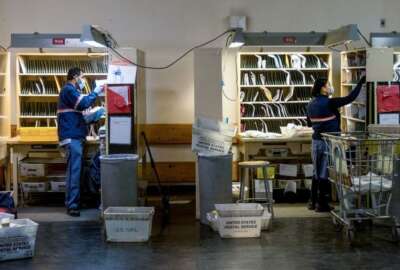

The Postal Service, as it prepares for the latest effort to consolidate its delivery network, is pulling the plug on pending work from its last attempt that began...
The Postal Service, as it prepares for the latest effort to consolidate its delivery network, is pulling the plug on pending work from its last attempt that began nearly a decade ago.
USPS announced Monday that it is ending “all activity” related to 57 open Area Mail Processing (AMP) studies, which are reviews of proposed closures or consolidations of mail processing facilities.
The last major consolidation effort ramped up in 2011, when USPS reviewed hundreds of facilities as candidates for consolidation.
The agency, however, remains focused on Postmaster General Louis DeJoy’s current plans to cut costs from the agency’s delivery network.
USPS said in the announcement that the agency plans to “reassess the role of all processing facilities” as part of its 10-year reform plans.
“The Postal Service is moving forward with the Delivering for America Plan, which includes strategies for the development of a mail processing network that enables more precise, efficient and reliable service,” the agency said. “By using best-in-class logistics practices, the Postal Service is driving efficiency and service performance improvement to fuel revenue growth and customer retention.”
USPS spokeswoman Sue Brennan said Monday that USPS launched the AMP studies in 2011, “due to the loss in First-Class Mail volume and the increasing deployment of state-of-the-art mail processing equipment.”
“Many facilities were studied for consolidations. Some consolidations occurred, some were partially implemented, and others had no movement,” Brennan said.
Last year, the Postal Service announced its Delivering for America 10-year strategic plan. The studies that remain open will be ended as the Postal Service continues to move forward with its Delivering for America plan.
DeJoy, speaking at the American Enterprise Institute on July 27, said he plans to consolidate 500 facilities that USPS processes and moves mail through down to about 65 or 75 regional hubs.
Among the facilities that face consolidation, DeJoy said USPS will close 150 annexes — about 40 of which USPS opened to support a surge of packages during the peak holiday season at the end of last year.
The network consolidation plan will impact 1,000 transfer hubs and 100,000 carrier routes, as well as 10,000 delivery units, which USPS defines as post offices, stations, branches or carrier annexes that handle mail delivery functions.
DeJoy said during the AEI event that USPS may shed 50,000 jobs through natural attrition as part of this effort, but said he’s “committed to a stable workforce,” and would manage this headcount reduction through normal attrition, which results from employees retiring or leaving the agency.
Ron Stroman, a former deputy postmaster general and current member of the USPS Board of Governors, said last week during a board meeting that USPS plans to consolidate its delivery network into regional Sort and Delivery Centers will improve regional on-time delivery, provide better working conditions for employees while maintaining its nationwide retail infrastructure.
However, Stroman urged USPS management to “ensure complete transparency of plans to reconfigure our transportation and processing networks,” as well as prioritize regions of the country that have substantially underperformed because of network design issues.
Patrick Devine, USPS manager of contract administration and employee workplace programs told the American Postal Workers Union in a 2011 memo that the AMP studies would consider the mail volume and the capacity of each facility under review, “to increase efficiency and improve productivity.”
Devine, in the 2011 memo to APWU, said the agency was facing “one of the most difficult challenges in its history,” with a historic decline in first-class mail volume, and that network rationalization efforts were necessary “to continue to provide universal service at a reasonable cost for a long time to come.”
“The reality is we have an excess of equipment, staff and facilities to process a declining volume of mail. Consolidating some postal operations only makes logical business sense given the economic realities. It would be fiscally irresponsible not to do so,” he wrote.
Copyright © 2025 Federal News Network. All rights reserved. This website is not intended for users located within the European Economic Area.
Jory Heckman is a reporter at Federal News Network covering U.S. Postal Service, IRS, big data and technology issues.
Follow @jheckmanWFED


